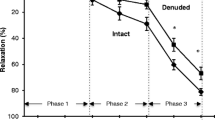Summary
Acetylcholine elicits an endothelium-dependent hyperpolarization of vascular smooth muscle cells. The experiments reported here tested the hypothesis that this hyperpolarization is mediated by the endothelium-derived relaxant factor (EDRF) identified as nitric oxide. Membrane potential was recorded with standard glass microelectrodes in smooth muscle cells in segments of rabbit femoral arteries. In endothelium-intact vessels, smooth muscle cells (resting potential: −67.0 ± 1.3 mV) hyperpolarized significantly (P < 0.001) by 5.7 ± 0.9 mV in response to acetylcholine (1 μM). Inhibition of EDRF, either in the presence of hemoglobin or by pretreatment with gossypol, attenuated the relaxation elicited by acetylcholine in endothelium-intact segments precontracted with 0.1 μM noradrenaline but had no significant effect on either the control membrane potential (−62.2 ± 1.9 mV and −68.5 ± 2.1 mV, respectively) or the hyperpolarization in response to acetylcholine (5.0 ± 1.6 mV and 5.8 ± 1.6 mV, respectively). In contrast, in vessel segments with the endothelium removed, the hyperpolarization in response to acetylcholine was abolished although the control membrane potential (−68.0 ± 5.1 mV) was not significantly different from that in endotheliumintact vessels. Sodium nitroprusside, an endothelium-dependent vasodilator and exogenous analog of EDRF, also had no significant effect on membrane potential. The lack of response to acetylcholine was not merely the result of nonspecific damage to the smooth muscle cells: vessel segments without endothelium were still able to hyperpolarize in response to various other vasodilators. These results suggest that the endothelium-dependent hyperpolarization of vascular smooth muscle cells in response to acetylcholine is not mediated by EDRF.
Similar content being viewed by others
References
Beetens JR, van Hove C, Rampart M, Herman AG (1983) Acetylcholine stimulates the release of prostacyclin by rabbit aorta endothelium. J Pharm Pharmacol 35:251–252
Busse R, Trogisch G, Bassenge E (1985) The role of the endothelium in the control of vascular tone. Bas Res Cardiol 80:475–490
Busse R, Lückhoff A, Mülsch A, Bassenge E (1988a) Modulation of EDRF release assessed by guanylate cyclase assay. In: Bevan JA, Majewski H, Maxwell RA, Story DF (eds) Vascular neuroeffector mechanisms. IRL Press, Oxford, pp 111–118
Busse R, Fichtner H, Lückhoff A, Kohlhardt M (1988b) Hyperpolarization and increased free calcium in acetylcholinestimulated endothelial cells. Am J Physiol 255:965–969
Cheung DW, Mackay MJ (1985) The effects of sodium nitroprusside and 8-bromocyclic GMP on electrical and mechanical activities of the rat tail artery. Br J Pharmacol 86:117–124
Doyle MP, Hoekstra JW (1981) Oxidation of nitrogen oxides by bound dioxygen in hemoproteins. J Inorg Biochem 14:351–358
Feletou M, Vanhoutte PM (1986) Endothelium-derived factor(s) and membrane potential of vascular smooth muscle. Blood Vessels 23(2):68
Feletou M, Vanhoutte PM (1988) Endothelium-dependent hyperpolarization of canine coronary smooth muscle. Br J Pharmacol 93:515–524
Förstermann U, Goppelt-Strübe M, Frölich JC, Busse R (1986) Inhibitors of acyl-coenzyme A:Lysolecithin acyltransferase activate the production of endothelium-derived vascular relaxing factor (EDRF). J Pharmacol Exp Ther 238:352–359
Furchgott RE (1983) Role of endothelium in responses of vascular smooth muscle. Circ Res 53:557–573
Haeusler G, de Peyer J-E (1986) Role of membrane electrical events in endothelium and non-endothelium dependent vasodilation. Naunyn-Schmiedeberg's Arch Pharmacol 332:R56
Haeusler G, Thorens S (1976) The pharmacology of vaso-active antihypertensives. In: Bevan JA, Bumstock G, Johanssen B, Maxwell R, Nedergaard O (eds) Vascular neuroeffector mechanisms. Karger, Basel, pp 232–241
Ignarro JL, Edwards JC, Gruetter DY, Barry BK, Gruetter CA (1980) Possible involvement of S-nitrosothiols in the activation of guanylate cyclase by nitroso compounds. FEBS Lett 110: 275–278
Ito Y, Suzuki H, Kuriyama H (1978) Effects of sodium nitroprusside on smooth muscle cells of rabbit pulmonary artery and portal vein. J Pharmacol Exp Ther 207:1022–1031
Itoh T, Kajiwara M, Kitamura K, Kuriyama H (1981) Effects of vasodilator agents on smooth muscle cells of the coronary artery of the pig. Br J Pharmacol 74:455–468
Kauser K, Stekiel WJ, Harder DR (1988) Possible hyperpolarizing action of EDRF in arterial muscle. FASEB J 2:A315
Komori K, Suzuki H (1987) Electrical responses of smooth muscle cells during cholinergic vasodilation in the rabbit saphenous artery. Circ Res 61:586–593
Komori K, Vanhoutte PM (1988) Effects of nitric oxide on electrical and mechanical properties of smooth muscle cells of canine mesenteric and rabbit saphenous arteries. FASEB J 2:A517
Kreye VAW (1980) Sodium nitroprusside: approaches towards the elucidation of its mode of action. Trends Pharmacol Sci 1:384–388
Martin W, Villani GM, Jothianandan D, Furchgott RF (1985) Selective blockade of endothelium-dependent and glyceryl trinitrate-induced relaxation by hemoglobin and by methylene blue in the rabbit aorta. J Pharmacol Exp Ther 232:708–716
Palmer RMJ, Ferrige AG, Moncada S (1987) Nitric oxide release accounts for the biological activity of endothelium-derived relaxing factor. Nature 327:524–526
Pohl U, Deszi L, Simon B, Busse R (1987) Selective inhibition of endothelium-dependent dilation in resistance-sized vessels in vivo. Am J Physiol 253:683–688
Spagnoli LG, Villaschi S, Neri L, Palmieri G (1982) Gap junctions in myoendothelial bridges of rabbit carotid arteries. Experientia 38:124–125
Taugner R, Kirchheim H, Forssmann WG (1984) Myoendothelial contacts in glomerular arterioles and in renal interglobular arteries of rat, mouse, and Tupaia belangeri. Cell Tissue Res 235:319–325
Trapani A, Matsuki N, Abel PW, Hermsmeyer K (1981) Norepinephrine produces tension through electromechanical coupling in rabbit ear artery. Eur J Pharmacol 72:87–91
Vanhoutte PM (1987) The end of the quest? Nature 327:459–460
Author information
Authors and Affiliations
Additional information
Send offprint requests to R. Busse at the above address
Rights and permissions
About this article
Cite this article
Huang, A.H., Busse, R. & Bassenge, E. Endothelium-dependent hyperpolarization of smooth muscle cells in rabbit femoral arteries is not mediated by EDRF (nitric oxide). Naunyn-Schmiedeberg's Arch Pharmacol 338, 438–442 (1988). https://doi.org/10.1007/BF00172124
Received:
Accepted:
Issue Date:
DOI: https://doi.org/10.1007/BF00172124



